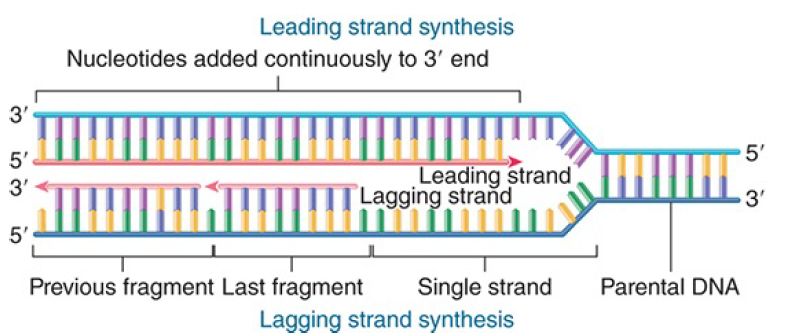


 النبات
النبات
 الحيوان
الحيوان
 الأحياء المجهرية
الأحياء المجهرية
 علم الأمراض
علم الأمراض
 التقانة الإحيائية
التقانة الإحيائية
 التقنية الحيوية المكروبية
التقنية الحيوية المكروبية
 التقنية الحياتية النانوية
التقنية الحياتية النانوية
 علم الأجنة
علم الأجنة
 الأحياء الجزيئي
الأحياء الجزيئي
 علم وظائف الأعضاء
علم وظائف الأعضاء
 الغدد
الغدد
 المضادات الحيوية
المضادات الحيوية|
Read More
Date: 15-6-2021
Date: 27-4-2016
Date: 1-1-2021
|
The Two New DNA Strands Have Different Modes of Synthesis
KEY CONCEPT
- The DNA polymerase advances continuously when it synthesizes the leading strand (5′–3′), but synthesizes the lagging strand by making short fragments that are subsequently joined together.
The antiparallel structure of the two strands of duplex DNA poses a problem for replication. As the replication fork advances, daughter strands must be synthesized on both of the exposed parental single strands. The fork template strand moves in the direction from 5′–3′ on one strand and in the direction from 3′–5′ on the other strand.
Yet DNA is synthesized only from a 5′ end toward a 3′ end (by adding a new nucleotide to the growing 3′ end) on a template that is 3′ to 5′. The problem is solved by synthesizing the new strand on the 5′ to 3′ template in a series of short fragments, each synthesized in the “backward” direction; that is, with the customary 5′–3′ polarity.
Consider the region immediately behind the replication fork, as illustrated in FIGURE 1. Researchers describe events in terms of the different properties of each of the newly synthesized strands:
- On the leading strand (sometimes called the forward strand) DNA synthesis can proceed continuously in the 5′ to 3′ direction as the parental duplex is unwound.
- On the lagging strand a stretch of single-stranded parental DNA must be exposed, and then a segment is synthesized in the reverse direction (relative to fork movement). A series of these fragments are synthesized, each 5′–3′; they then are joined together to create an intact lagging strand.

FIGURE 1 The leading strand is synthesized continuously, whereas the lagging strand is synthesized discontinuously.
Discontinuous replication can be followed by the fate of a very brief label of radioactivity. The label enters newly synthesized DNA in the form of short fragments of approximately 1,000 to 2,000 bases in length. These Okazaki fragments are found in replicating DNA in both prokaryotes and eukaryotes. After longer periods of incubation, the label enters larger segments of DNA. The transition results from covalent linkages between Okazaki fragments.
The lagging strand must be synthesized in the form of Okazaki fragments. For a long time, it was unclear whether the leading strand is synthesized in the same way or is synthesized continuously. All newly synthesized DNA is found as short fragments in E. coli. Superficially, this suggests that both strands are synthesized discontinuously. It turns out, however, that not all of the fragment population represents bona fide Okazaki fragments; some are pseudofragments that have been generated by breakage in a DNA strand that actually was synthesized as a continuous chain. The source of this breakage is the incorporation of some uracil into DNA in place of thymine. When the uracil is removed by a repair system, the leading strand has breaks until a thymine isinserted. Thus, the lagging strand is synthesized discontinuously and the leading strand is synthesized continuously. This is called semidiscontinuous replication.



|
|
|
|
"إنقاص الوزن".. مشروب تقليدي قد يتفوق على حقن "أوزيمبيك"
|
|
|
|
|
|
|
الصين تحقق اختراقا بطائرة مسيرة مزودة بالذكاء الاصطناعي
|
|
|
|
|
|
|
مكتب السيد السيستاني يعزي أهالي الأحساء بوفاة العلامة الشيخ جواد الدندن
|
|
|